roof NISSAN QASHQAI 2017 Owner´s Manual
[x] Cancel search | Manufacturer: NISSAN, Model Year: 2017, Model line: QASHQAI, Model: NISSAN QASHQAI 2017Pages: 508, PDF Size: 2.68 MB
Page 11 of 508
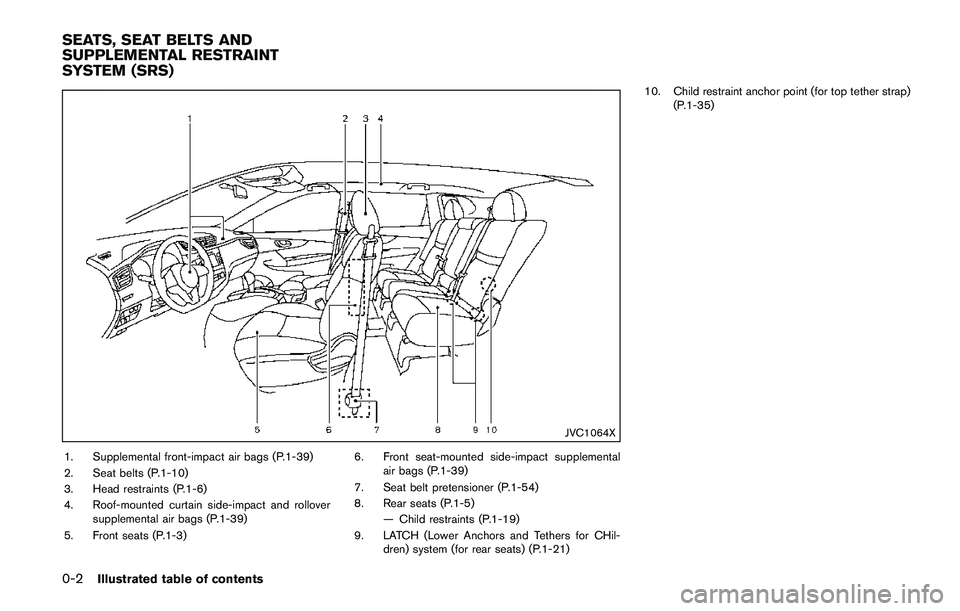
0-2Illustrated table of contents
JVC1064X
1. Supplemental front-impact air bags (P.1-39)
2. Seat belts (P.1-10)
3. Head restraints (P.1-6)
4. Roof-mounted curtain side-impact and rollover
supplemental air bags (P.1-39)
5. Front seats (P.1-3)6. Front seat-mounted side-impact supplemental
air bags (P.1-39)
7. Seat belt pretensioner (P.1-54)
8. Rear seats (P.1-5)
— Child restraints (P.1-19)
9. LATCH (Lower Anchors and Tethers for CHil-
dren) system (for rear seats) (P.1-21)10. Child restraint anchor point (for top tether strap)
(P.1-35)
SEATS, SEAT BELTS AND
SUPPLEMENTAL RESTRAINT
SYSTEM (SRS)
Page 12 of 508
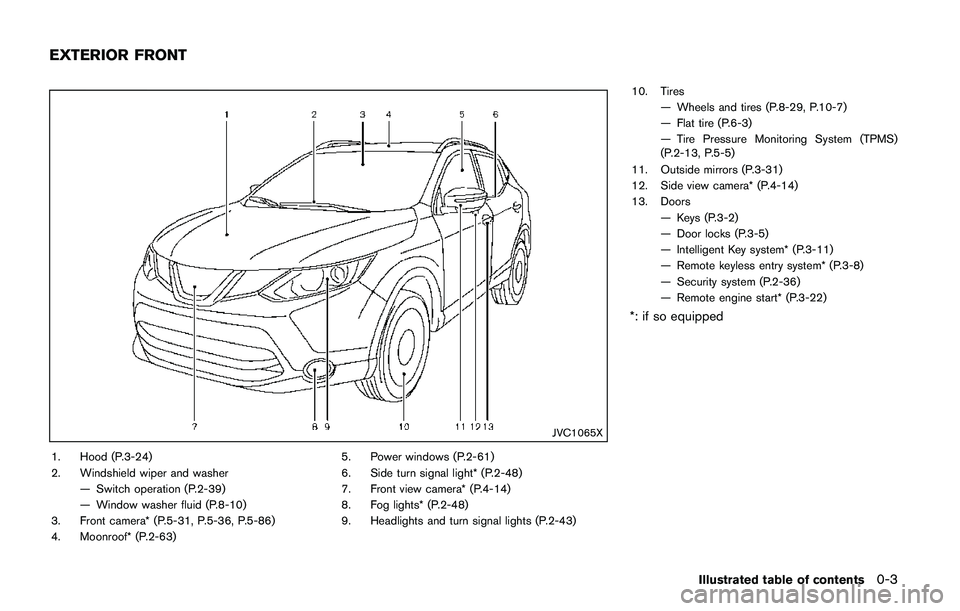
JVC1065X
1. Hood (P.3-24)
2. Windshield wiper and washer
— Switch operation (P.2-39)
— Window washer fluid (P.8-10)
3. Front camera* (P.5-31, P.5-36, P.5-86)
4. Moonroof* (P.2-63)5. Power windows (P.2-61)
6. Side turn signal light* (P.2-48)
7. Front view camera* (P.4-14)
8. Fog lights* (P.2-48)
9. Headlights and turn signal lights (P.2-43)10. Tires
— Wheels and tires (P.8-29, P.10-7)
— Flat tire (P.6-3)
— Tire Pressure Monitoring System (TPMS)
(P.2-13, P.5-5)
11. Outside mirrors (P.3-31)
12. Side view camera* (P.4-14)
13. Doors
— Keys (P.3-2)
— Door locks (P.3-5)
— Intelligent Key system* (P.3-11)
— Remote keyless entry system* (P.3-8)
— Security system (P.2-36)
— Remote engine start* (P.3-22)
*: if so equipped
Illustrated table of contents0-3
EXTERIOR FRONT
Page 13 of 508
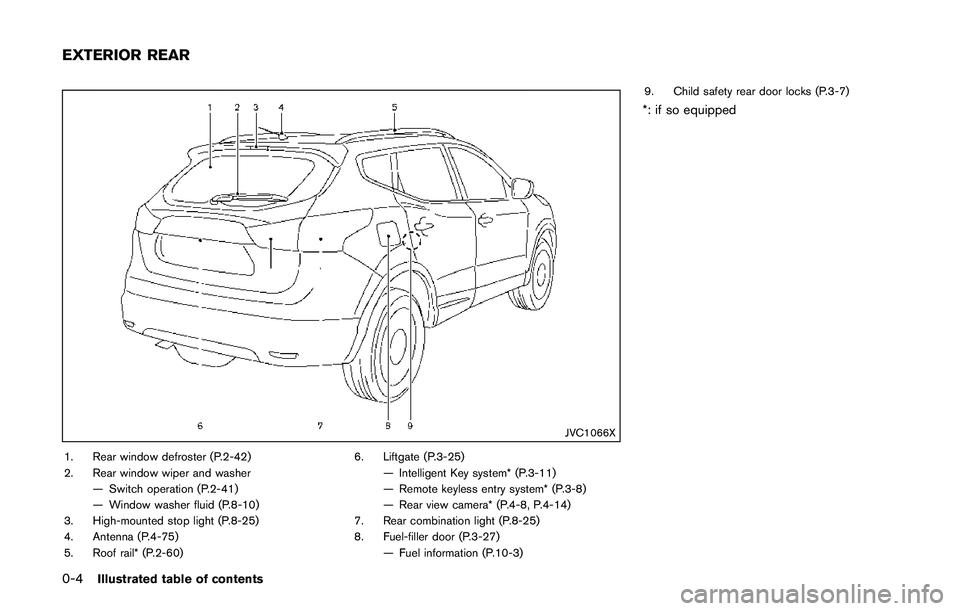
0-4Illustrated table of contents
JVC1066X
1. Rear window defroster (P.2-42)
2. Rear window wiper and washer
— Switch operation (P.2-41)
— Window washer fluid (P.8-10)
3. High-mounted stop light (P.8-25)
4. Antenna (P.4-75)
5. Roof rail* (P.2-60)6. Liftgate (P.3-25)
— Intelligent Key system* (P.3-11)
— Remote keyless entry system* (P.3-8)
— Rear view camera* (P.4-8, P.4-14)
7. Rear combination light (P.8-25)
8. Fuel-filler door (P.3-27)
— Fuel information (P.10-3)9. Child safety rear door locks (P.3-7)
*: if so equipped
EXTERIOR REAR
Page 14 of 508
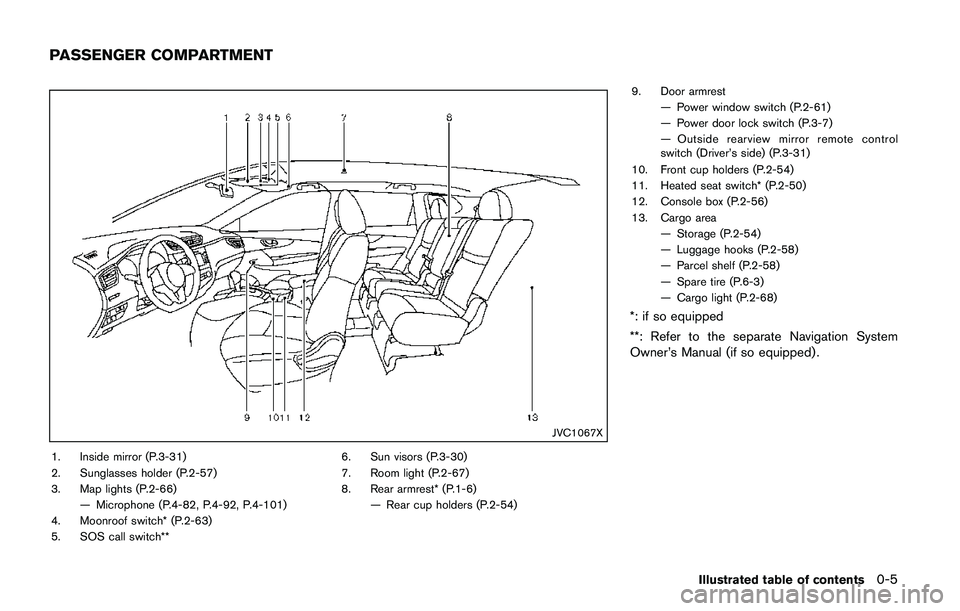
JVC1067X
1. Inside mirror (P.3-31)
2. Sunglasses holder (P.2-57)
3. Map lights (P.2-66)
— Microphone (P.4-82, P.4-92, P.4-101)
4. Moonroof switch* (P.2-63)
5. SOS call switch**6. Sun visors (P.3-30)
7. Room light (P.2-67)
8. Rear armrest* (P.1-6)
— Rear cup holders (P.2-54)9. Door armrest
— Power window switch (P.2-61)
— Power door lock switch (P.3-7)
— Outside rearview mirror remote control
switch (Driver’s side) (P.3-31)
10. Front cup holders (P.2-54)
11. Heated seat switch* (P.2-50)
12. Console box (P.2-56)
13. Cargo area
— Storage (P.2-54)
— Luggage hooks (P.2-58)
— Parcel shelf (P.2-58)
— Spare tire (P.6-3)
— Cargo light (P.2-68)
*: if so equipped
**: Refer to the separate Navigation System
Owner’s Manual (if so equipped) .
Illustrated table of contents0-5
PASSENGER COMPARTMENT
Page 20 of 508
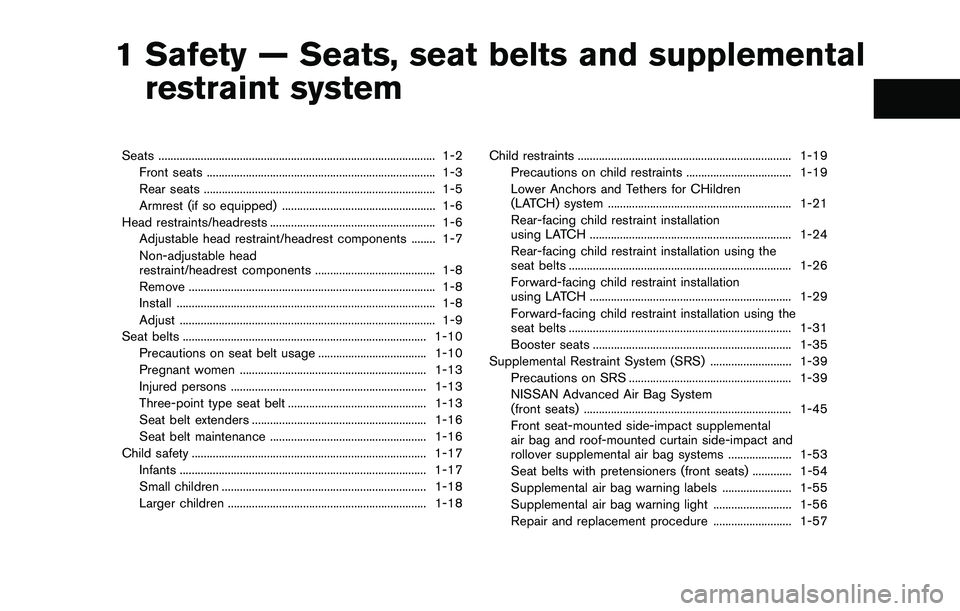
1 Safety — Seats, seat belts and supplemental
restraint system
Seats ............................................................................................ 1-2
Front seats ............................................................................ 1-3
Rear seats ............................................................................. 1-5
Armrest (if so equipped) ................................................... 1-6
Head restraints/headrests ....................................................... 1-6
Adjustable head restraint/headrest components ........ 1-7
Non-adjustable head
restraint/headrest components ........................................ 1-8
Remove .................................................................................. 1-8
Install ...................................................................................... 1-8
Adjust ..................................................................................... 1-9
Seat belts ................................................................................. 1-10
Precautions on seat belt usage .................................... 1-10
Pregnant women .............................................................. 1-13
Injured persons ................................................................. 1-13
Three-point type seat belt .............................................. 1-13
Seat belt extenders .......................................................... 1-16
Seat belt maintenance .................................................... 1-16
Child safety .............................................................................. 1-17
Infants .................................................................................. 1-17
Small children .................................................................... 1-18
Larger children .................................................................. 1-18Child restraints ....................................................................... 1-19
Precautions on child restraints ................................... 1-19
Lower Anchors and Tethers for CHildren
(LATCH) system ............................................................. 1-21
Rear-facing child restraint installation
using LATCH ................................................................... 1-24
Rear-facing child restraint installation using the
seat belts .......................................................................... 1-26
Forward-facing child restraint installation
using LATCH ................................................................... 1-29
Forward-facing child restraint installation using the
seat belts .......................................................................... 1-31
Booster seats .................................................................. 1-35
Supplemental Restraint System (SRS) ........................... 1-39
Precautions on SRS ...................................................... 1-39
NISSAN Advanced Air Bag System
(front seats) ..................................................................... 1-45
Front seat-mounted side-impact supplemental
air bag and roof-mounted curtain side-impact and
rollover supplemental air bag systems ..................... 1-53
Seat belts with pretensioners (front seats) ............. 1-54
Supplemental air bag warning labels ....................... 1-55
Supplemental air bag warning light .......................... 1-56
Repair and replacement procedure .......................... 1-57
Page 58 of 508
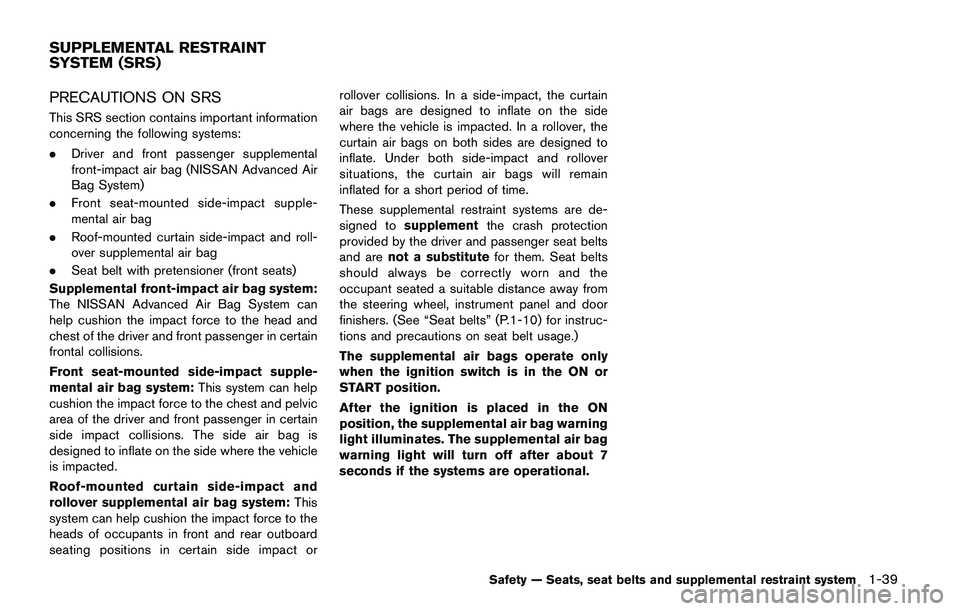
PRECAUTIONS ON SRS
This SRS section contains important information
concerning the following systems:
.Driver and front passenger supplemental
front-impact air bag (NISSAN Advanced Air
Bag System)
.Front seat-mounted side-impact supple-
mental air bag
.Roof-mounted curtain side-impact and roll-
over supplemental air bag
.Seat belt with pretensioner (front seats)
Supplemental front-impact air bag system:
The NISSAN Advanced Air Bag System can
help cushion the impact force to the head and
chest of the driver and front passenger in certain
frontal collisions.
Front seat-mounted side-impact supple-
mental air bag system:This system can help
cushion the impact force to the chest and pelvic
area of the driver and front passenger in certain
side impact collisions. The side air bag is
designed to inflate on the side where the vehicle
is impacted.
Roof-mounted curtain side-impact and
rollover supplemental air bag system:This
system can help cushion the impact force to the
heads of occupants in front and rear outboard
seating positions in certain side impact orrollover collisions. In a side-impact, the curtain
air bags are designed to inflate on the side
where the vehicle is impacted. In a rollover, the
curtain air bags on both sides are designed to
inflate. Under both side-impact and rollover
situations, the curtain air bags will remain
inflated for a short period of time.
These supplemental restraint systems are de-
signed tosupplementthe crash protection
provided by the driver and passenger seat belts
and arenot a substitutefor them. Seat belts
should always be correctly worn and the
occupant seated a suitable distance away from
the steering wheel, instrument panel and door
finishers. (See “Seat belts” (P.1-10) for instruc-
tions and precautions on seat belt usage.)
The supplemental air bags operate only
when the ignition switch is in the ON or
START position.
After the ignition is placed in the ON
position, the supplemental air bag warning
light illuminates. The supplemental air bag
warning light will turn off after about 7
seconds if the systems are operational.
Safety — Seats, seat belts and supplemental restraint system1-39
SUPPLEMENTAL RESTRAINT
SYSTEM (SRS)
Page 62 of 508
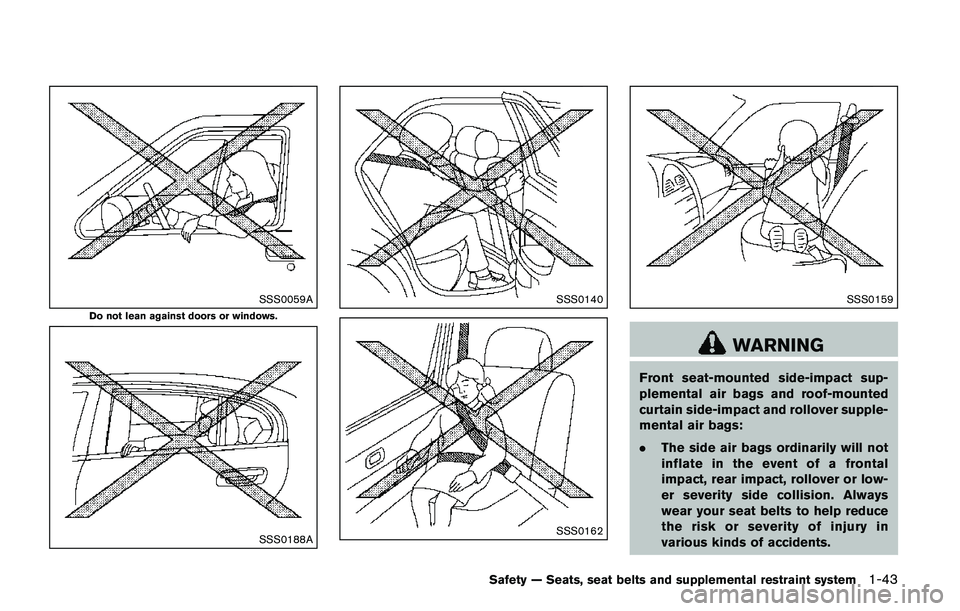
SSS0059A
Do not lean against doors or windows.
SSS0188A
SSS0140
SSS0162
SSS0159
WARNING
Front seat-mounted side-impact sup-
plemental air bags and roof-mounted
curtain side-impact and rollover supple-
mental air bags:
.The side air bags ordinarily will not
inflate in the event of a frontal
impact, rear impact, rollover or low-
er severity side collision. Always
wear your seat belts to help reduce
the risk or severity of injury in
various kinds of accidents.
Safety — Seats, seat belts and supplemental restraint system1-43
Page 63 of 508
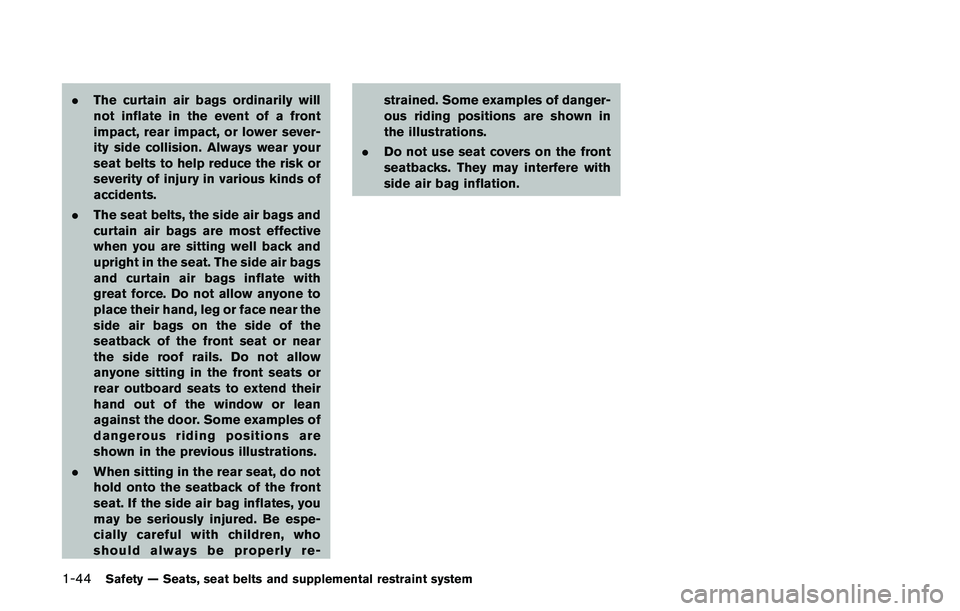
1-44Safety — Seats, seat belts and supplemental restraint system
.The curtain air bags ordinarily will
not inflate in the event of a front
impact, rear impact, or lower sever-
ity side collision. Always wear your
seat belts to help reduce the risk or
severity of injury in various kinds of
accidents.
.The seat belts, the side air bags and
curtain air bags are most effective
when you are sitting well back and
upright in the seat. The side air bags
and curtain air bags inflate with
great force. Do not allow anyone to
place their hand, leg or face near the
side air bags on the side of the
seatback of the front seat or near
the side roof rails. Do not allow
anyone sitting in the front seats or
rear outboard seats to extend their
hand out of the window or lean
against the door. Some examples of
dangerous riding positions are
shown in the previous illustrations.
.When sitting in the rear seat, do not
hold onto the seatback of the front
seat. If the side air bag inflates, you
may be seriously injured. Be espe-
cially careful with children, who
should always be properly re-strained. Some examples of danger-
ous riding positions are shown in
the illustrations.
.Do not use seat covers on the front
seatbacks. They may interfere with
side air bag inflation.
Page 64 of 508
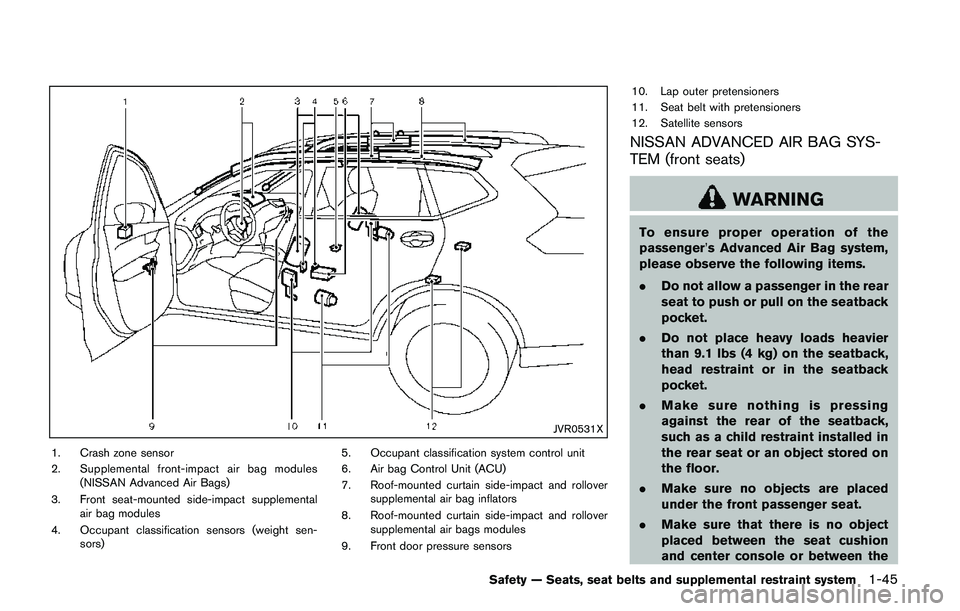
JVR0531X
1. Crash zone sensor
2. Supplemental front-impact air bag modules
(NISSAN Advanced Air Bags)
3. Front seat-mounted side-impact supplemental
air bag modules
4. Occupant classification sensors (weight sen-
sors)5. Occupant classification system control unit
6. Air bag Control Unit (ACU)
7. Roof-mounted curtain side-impact and rollover
supplemental air bag inflators
8. Roof-mounted curtain side-impact and rollover
supplemental air bags modules
9. Front door pressure sensors10. Lap outer pretensioners
11. Seat belt with pretensioners
12. Satellite sensors
NISSAN ADVANCED AIR BAG SYS-
TEM (front seats)
WARNING
To ensure proper operation of the
passenger’s Advanced Air Bag system,
please observe the following items.
.Do not allow a passenger in the rear
seat to push or pull on the seatback
pocket.
.Do not place heavy loads heavier
than 9.1 lbs (4 kg) on the seatback,
head restraint or in the seatback
pocket.
.Make sure nothing is pressing
against the rear of the seatback,
such as a child restraint installed in
the rear seat or an object stored on
the floor.
.Make sure no objects are placed
under the front passenger seat.
.Make sure that there is no object
placed between the seat cushion
and center console or between the
Safety — Seats, seat belts and supplemental restraint system1-45
Page 65 of 508
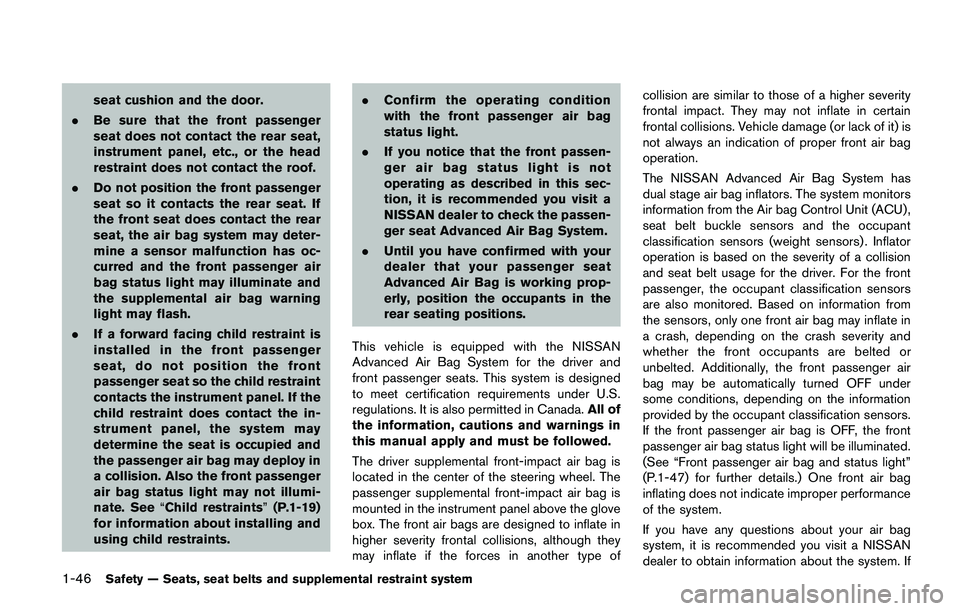
1-46Safety — Seats, seat belts and supplemental restraint system
seat cushion and the door.
.Be sure that the front passenger
seat does not contact the rear seat,
instrument panel, etc., or the head
restraint does not contact the roof.
.Do not position the front passenger
seat so it contacts the rear seat. If
the front seat does contact the rear
seat, the air bag system may deter-
mine a sensor malfunction has oc-
curred and the front passenger air
bag status light may illuminate and
the supplemental air bag warning
light may flash.
.If a forward facing child restraint is
installed in the front passenger
seat, do not position the front
passenger seat so the child restraint
contacts the instrument panel. If the
child restraint does contact the in-
strument panel, the system may
determine the seat is occupied and
the passenger air bag may deploy in
a collision. Also the front passenger
air bag status light may not illumi-
nate. See“Child restraints”(P.1-19)
for information about installing and
using child restraints..Confirm the operating condition
with the front passenger air bag
status light.
.If you notice that the front passen-
ger air bag status light is not
operating as described in this sec-
tion, it is recommended you visit a
NISSAN dealer to check the passen-
ger seat Advanced Air Bag System.
.Until you have confirmed with your
dealer that your passenger seat
Advanced Air Bag is working prop-
erly, position the occupants in the
rear seating positions.
This vehicle is equipped with the NISSAN
Advanced Air Bag System for the driver and
front passenger seats. This system is designed
to meet certification requirements under U.S.
regulations. It is also permitted in Canada.All of
the information, cautions and warnings in
this manual apply and must be followed.
The driver supplemental front-impact air bag is
located in the center of the steering wheel. The
passenger supplemental front-impact air bag is
mounted in the instrument panel above the glove
box. The front air bags are designed to inflate in
higher severity frontal collisions, although they
may inflate if the forces in another type ofcollision are similar to those of a higher severity
frontal impact. They may not inflate in certain
frontal collisions. Vehicle damage (or lack of it) is
not always an indication of proper front air bag
operation.
The NISSAN Advanced Air Bag System has
dual stage air bag inflators. The system monitors
information from the Air bag Control Unit (ACU) ,
seat belt buckle sensors and the occupant
classification sensors (weight sensors) . Inflator
operation is based on the severity of a collision
and seat belt usage for the driver. For the front
passenger, the occupant classification sensors
are also monitored. Based on information from
the sensors, only one front air bag may inflate in
a crash, depending on the crash severity and
whether the front occupants are belted or
unbelted. Additionally, the front passenger air
bag may be automatically turned OFF under
some conditions, depending on the information
provided by the occupant classification sensors.
If the front passenger air bag is OFF, the front
passenger air bag status light will be illuminated.
(See “Front passenger air bag and status light”
(P.1-47) for further details.) One front air bag
inflating does not indicate improper performance
of the system.
If you have any questions about your air bag
system, it is recommended you visit a NISSAN
dealer to obtain information about the system. If